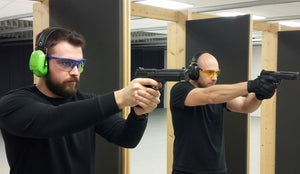Until the late 1950s, when the Weaver stance was invented, the dominant mindset in handgun training was point shooting: fast, instinctive, and often inaccurate. Most shooters relied on natural posture, like the Isosceles stance, to draw quickly and fire first.
Back then, revolvers were still more common than pistols. The art of shooting was already well established. But it took one man, Jack Weaver, to bridge the gap between speed and precision.
His stance emphasized two-handed control, sight alignment, and recoil management. It looked unusual at the time, but it quickly became the foundation for shooting a pistol using the Weaver stance.
Today, the benefits are clear: improved recoil management, reduced muzzle rise, and faster follow-up shots. No wonder it’s still taught in police academies, the military, and competitive shooting.
But is the Weaver stance still the best shooting stance for accuracy? A lot has changed since the mid-20th century, so let’s find out.
What is the Weaver Stance?
The Weaver shooting stance is one of the first positions many shooters learn. Think “bladed and braced”:
Start with your feet about shoulder-width. Support-side foot forward, strong-side foot back at roughly a 45° angle.
Then, as you present the pistol, your dominant hand takes a full, high grip while the support hand locks in and helps manage recoil. Your shooting arm is mostly extended with a slight bend; your support arm is bent with the elbow pointed down.
That’s the proper Weaver stance technique: stable, controllable, and fast to the sights.
When was it invented, and by whom? In 1959, Los Angeles County Deputy Sheriff Jack Weaver started winning Jeff Cooper’s Leatherslap matches with this new stance. He brought the gun to eye level and used the sights instead of pure point shooting.
The match used head-to-head balloon bursts at 21 feet, and Weaver’s two-handed, sighted fire proved both fast and accurate. It stood out immediately.
Cooper became a fan of Weaver’s stance. So much, that he helped popularize it, turning it into a new standard for tactical shooting stances.
So much so that, in 1963, three-time Leatherslap champion Elden Carl convinced Cooper to shorten the stage to 15 feet to keep one-handed speed shooting in the game. And it’s good he did so, as we want to protect that heritage too.
Meanwhile, the Weaver kept gaining ground. The FBI formally adopted it in 1982, and many academies taught a bladed stance through the ’80s–’90s.
Now, is the Weaver stance the best? Even better than Isosceles? Here’s the real answer: no one becomes a great shooter by mastering just one stance. But when done right, the Weaver is a rock-solid foundation for pistol grip and control, and it belongs in your toolkit.
So before diving into all the extra details, here’s a quick step-by-step reminder of how to do Weaver stance properly.
How to shoot a pistol using the Weaver Stance
The Weaver stance, just as Jack Weaver created it, goes as follows:
First, you stand in a bladed angle towards your target:
-
Blade toward the target: Feet shoulder-width. Knees slightly bent.
-
Foot placement: Strong-side foot a small step back; support-side foot just a bit forward. Weight over the balls of your feet.
Next, comes the beaver stance double-grip:
-
Shooting arm: almost fully extended with a slight bend.
-
Support arm: bent, elbow down, hand high under the trigger guard, wrapping the strong hand. This Build gentle “push–pull” tension: strong hand drives forward, support hand resists slightly.
-
Head & sights: Keep your head upright and bring the sights to your eyes. Track the front sight, press the trigger straight to the rear, and ride the reset.
Now, how does this make you more accurate and faster?
Benefits of the Weaver Stance
Why did the Weaver stance become so popular? Because it works really well with the physics of the gun. You blade the body, set the support-side foot forward and the strong-side foot back, keep the knees soft, and use two hands in controlled tension.
That was Jack Weaver’s genius: a stance that soaks up recoil and tracks the sights cleanly. It’s a steady, repeatable way to run a pistol fast.
Here’s why many tactical and law-enforcement shooters have leaned on the Weaver stance for shooting:
Better recoil control
The staggered feet and slight forward bias let your body act like a brake. Strong-side foot back, hips angled about 45°. Add firm two-hand pressure and the gun lifts less. That’s pistol grip and control done right.
Faster follow-up shots
When you hear talking about the weaver stance, you hear about isometric tension. This means pushing with the firing hand, pull slightly with the support hand. This is so effective because it makes the muzzle return to your visual index quicker. Shorter splits, cleaner cadence.
Better accuracy
Because the gun is more controlled, you get back on the sights sooner. That’s how you tighten groups in less time.
Mobility with stability
The staggered stance feels “ready to drive.” It plants well for recoil but still lets you step, pivot, and adjust angles without losing balance. It’s core shooting stance fundamentals.
How to Perfect Your Weaver Stance
Shooting is a perishable skill. Even if you’ve been at it for years, you still need reps. Range time, dry fire, and a few smart drills. That’s just how you keep the edge.
When we talk shooting stance fundamentals, don’t overthink the math. Is it exactly 45°? Are your knees at 5%? This isn't a geometry class. Focus on feel and repeatability and you’ll be alright.
A few simple tips for proper Weaver stance technique:
-
Blade, don’t twist: Hips naturally angled somewhere around 30–45°. Don’t chase a perfect angle.
-
Solid grip, don’t squeeze: Let the support hand do more of the squeezing. Keep the trigger press straight to the rear.
-
Push–pull, but easy: A touch of forward pressure with the strong hand, slight rearward tension with the support hand. Enough to control recoil—not enough to shake the sights.
-
Head up, eyes level: Bring the pistol to your eyes. Watch the front sight (or dot) lift and settle. That’s how Jack Weaver won Leatherslap
Once you master the Weaver stance, you can tweak it as needed. Just like Chapman did.
The Chapman Stance
Police officer Ray Chapman streamlined the top half of Weaver. Same lower body, bladed and braced, but a key change up top:
-
Strong arm fully extended/locked for bone support.
-
Support arm bent, elbow down to drive the gun back to the sights.
Why try Chapman’s stance? It channels recoil through your skeleton, which can make sight return feel very consistent. Recoil management is personal, so try both techniques and see what prints the best hits for you.
And while we are at it, let us know: Is recoil control your main headache? Then, try one of our 45 Blast comps. They help reduce muzzle rise and felt recoil by 60%. Whether you are just learning, or gearing up for competition, they sure will give you the extra edge.
Weaver Stance vs. Isosceles Stance
As we explain in our full guide to shooting stance fundamentals, how you stand depends on the scenario. There’s no one winner. It’s about choosing the right stance for the moment.
Most instructors start with Isosceles because it’s simple and repeatable for newcomers. Square to the target, both arms out, shoulders forward. From there, the Weaver stance is a natural progression when you want more pistol grip and control, with a bladed posture.
The Weaver stance offers better mobility and angles, stronger recoil control, and a narrower profile. That’s why it’s such a solid option for dynamic shooting.
But, like everything, it’s not perfect. A bladed torso can leave the non-dominant side more exposed, even with armor. In fact, Police1 cited this as a major concern because the support-side armpit can be less protected.
On the other hand, the Isosceles stance is easier to execute under stress, plays nicely with modern armor, and gives you a wider field of view. The tradeoff: you present a wider, easier target with less built-in lateral movement. And also, it is not as well adjusted for recoil management as the Weaver stance.
So, what’s the best shooting stance for accuracy?
Let the timer and targets decide. Run our Top 10 Pistol Shooting Drills in both the Weaver and Isosceles stances. Film your runs. Compare hits, splits, and sight return.
Most shooters end up using both: Weaver for control on movement or partials; Isosceles for speed and simplicity on open arrays.
After all, tactics are part of shooting. You have to navigate what happens—even the unexpected. Nail the basics so you can adapt.
How to Really Master Shooting Stances

Jack Weaver didn’t just sit at his desk to think his way into speed and accuracy. He trained his way there. He shot, saw how accurate it went, adjusted. The Weaver stance was born from reps, not theory.
Do the same. Keep the shooting stance fundamentals simple: feel, repeatability, and clean pistol grip and control. Don’t chase perfect angles. Chase consistent hits.
If you’re running Weaver, blade naturally, load the strong-side foot, and build light push–pull. Let the support hand drive the gun back to the sight line.
Best shooting stance for accuracy? The one that prints the tightest groups on your timer today. Test Weaver stance vs Isosceles stance, film your runs, and let the data pick your winner.
And getting the gear helps the learning curve. A 45 Blast comp flattens muzzle rise; a 45 Blast holster keeps your presentation identical, rep after rep. Put it all together—stance, drills, and smart gear—and you’ll see the gains.
So, what’s your stance?


